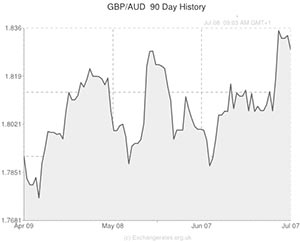
The Pound to Australian Dollar (GBP/AUD) exchange rate began the European session in a softer position.
Overnight the ‘Aussie’ was supported against several of its major currency counterparts by an impressive business sentiment report.
According to figures compiled by the National Bank of Australia (NBA), Business Confidence is on the increase with the index advancing from 7 in May to 8 in June.
This increase comes in spite of the Federal Budget outlined in May.
The NBA measure of Business Conditions also increased from -1 to 2 last month.
NAB chief economist Alan Oster said this of the result; ‘Firms still appear to have shrugged off the negative consumer reaction to the Federal Budget. Business Confidence has remained resilient for the better part of the year despite below average business conditions.’
The Pound to Australian Dollar fell from a high of 1.8286 after the report was released.
While the Reserve Bank of Australia recently attempted to talk down the Australian Dollar, the currency is gradually recovering losses against the US Dollar, with the AUD/USD pairing achieving a 3-day high during Australasian trading.
Further losses in the GBP to AUD pairing occurred during the European session as the UK published some lacklustre Manufacturing and Industrial Production data.
Both measures of output were expected to have increased in May, but both posted surprising month-on-month declines.
Sterling slid against the US Dollar, Euro, New Zealand Dollar and Australian Dollar as investors responded to the news that manufacturing production fell by 1.3% on a month-on-month basis.
The result saw strategist Marc Ostwald comment; ‘UK industrial production posted a very large downside surprise, driven by manufacturing […] the falls in all the export and investment balances act as a timely warning that although growth is stable, challenges facing our recovery still remain.’
The Pound to Australian Dollar exchange rate plummeted by over 0.5% after the news was released, with the pairing brushing a low of 1.8172.
Later today the GBP to AUD pairing could fluctuate in response to the UK’s GDP estimate for June.
Tomorrow’s Chinese Consumer Price Index and Australian Westpac Consumer Confidence index could also play a part in the direction taken by the GBP to ‘Aussie’ pairing as the week progresses.
UPDATED 22:25 GMT 08 July, 2014
Pound to Australian Dollar (GBP/AUD) Exchange Rate Struggling
Sterling continued trending in a weaker position against the Australian Dollar on Tuesday.
The Pound to Australian Dollar (GBP/AUD) exchange rate flat-lined early in the European session in response to the UK’s lackluster output reports for the manufacturing and industrial sectors.
The British asset may have gone on to recover ground against rivals like the Pound and Euro but its bearish relationship with the Australian Dollar continued. The Pound also remained lower against the New Zealand Dollar even as the National Institute of Economic and Social Research announced its UK growth estimate for June.
NIESR has estimated that the UK economy expanded by 0.9% in the three months to June. This forecast matches the report compiled by the Office for National Statistics.
The AUD/USD exchange rate, meanwhile, held gains in spite of an encouraging US JOLTs Jobs Opening report.
The upcoming Chinese inflation figures could have an impact on the Pound to Australian Dollar (GBP/AUD) exchange rate overnight.
UPDATED: 09:00 GMT 10 July 2014
Australian Unemployment Rate Climbs, Aussie Falls
The Pound to Australian Dollar (GBP/AUD) exchange rate posted a notable gain on Thursday as Australia’s unemployment report showed that the nation’s unemployment rate climbed to 6% in June.
Economists had expected it to hold at the revised level of 5.9%.
Although Australia was shown to have added 15,900 positions in June, the nation’s participation rate advanced modestly to 64.7% and May’s Part Time Employment Change figure was negatively revised to a drop of -27,200.
Full time employment also fell by -3,800.
China’s trade data didn’t help the Australian Dollar’s performance as it showed that the level of the nation’s imports climbed by 5.5% on the year in June, less than the 6.0% increase expected.
Australian Dollar (AUD) Exchange Rates
[table width=”100%” colwidth=”50|50|50|50|50″ colalign=”left|left|left|left|left”]
Currency, ,Currency,Rate ,
Australian Dollar, ,US Dollar, 0.9397,
,US Dollar, 0.9397,
Australian Dollar, ,Euro, 0.6910,
,Euro, 0.6910,
Australian Dollar, ,Pound, 0.5497,
,Pound, 0.5497,
Australian Dollar, ,New Zealand Dollar, 1.0688,
,New Zealand Dollar, 1.0688,
US Dollar, ,Australian Dollar, 1.0641,
,Australian Dollar, 1.0641,
Euro, ,Australian Dollar, 1.4474,
,Australian Dollar, 1.4474,
Pound Sterling, ,Australian Dollar, 1.8191,
,Australian Dollar, 1.8191,
New Zealand Dollar, ,Australian Dollar, 0.9339,
,Australian Dollar, 0.9339,
[/table]

Comments are closed.